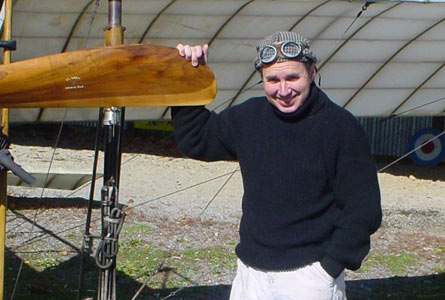
Dan Taylor knows the Blériot XI inside and out. As a pilot
and historian at Old Rhinebeck Aerodrome in Rhinebeck, New York, he
helped restore an original 1909 model to flyable condition and
serves as its official pilot during the Aerodrome's weekly air
shows. Below, Taylor guides you through a tour of this pioneering
aircraft, giving you a detailed view of its key systems and
aeronautical innovations.
 Front view
Front view



|

|

|
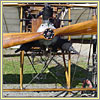
Large, paddle-like blades set at deep angles relative to each
other helped give the Blériot XI efficient thrust
despite its low-powered engine.

|
|
Propeller
The propeller on this plane is a typical design of the
period—a Chauvier-type style of propeller that was used
during that early period. These engines didn't turn up very
much. They were engines that maybe turned up 1,400 or 1,500
rpms, not like these big engines today that are turning up
real fast. A big, slow-turning prop was much more efficient.
The Wright brothers knew that, and their propellers were
turning very, very slowly but moving a lot of air. This is the
same thing with this engine, too. When I'm going down the
runway at maybe 30 miles per hour, it's only turning up about
1,800 rpms maximum.
|
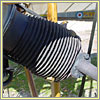
Built by motorcycle engine designer Alessandro Anzani, this
engine was lightweight but provided just enough power to keep
the Blériot XI aloft.

|
|
Anzani Engine
Many of the early airplanes carried very lightweight
air-cooled engines. They wanted a lightweight engine because
they didn't really figure out all the structures yet as far as
the bracing of the airplane. You look at airplanes today and
everything is streamlined. They know about metals. Back in the
early days, they didn't. They were experimenting. Everything
was a new trial. This is a 30- or 35-horsepower Anzani engine.
Blériot flew the English Channel with only a
25-horsepower engine, but this was the next step up. It
powered the airplane pretty well but it was prone to
overheating with its cast-iron cylinders because you weren't
moving very quickly. You were probably doing only 35 or 40
miles per hour. Hold on to your hat! It was an airplane engine
that was very useful for this airplane before the rotary
engines came out. The radial air-cooled engine worked pretty
well in its day.
|
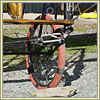
Since his light airplane was often thrown about by wind close
to the ground, Blériot designed landing gear that could
pivot, allowing his craft to turn slightly into the wind yet
keep rolling in the direction of the runway.

|
|
Main Landing Gear
Back in 1909-1910, these airplanes were feathers in the wind.
They had a problem with that. So what Blériot did was
make the landing gear pivot. It has what's called "castering
landing gear." As I take the airplane and I move it from side
to side, the landing gear actually pivots a little bit. And
the reason for that was so that the airplane could still land
at an angle and the wheels would track whatever direction you
were going. That's a feature that's still used today. Certain
bombers and airplanes actually have a castering gear that you
can dial in for a crosswind landing. Pretty remarkable:
technology from 1909.
|
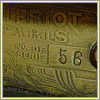
This original data plate from 1909 shows the aircraft's
origins and factory information.

|
|
Data Plate
This example here [of the Blériot XI] is serial number
56 of about 900 that were made. This [plane] was found at a
junkyard in Laconia, New Hampshire and all the parts that were
there showed a data plate and the data plate said "Paris,
France. Serial number 56. Blériot Type XI." It is the
oldest flying airplane in the United States and to have the
opportunity to fly an airplane like this here at Old Rhinebeck
is a great honor.
|
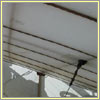
With a low-powered engine, these deeply curved wings are
needed to provide lift during slow flight.

|
|
Wing Design
The wings on this airplane, if you look at them, you'll notice
that the structure has a big what we call in aviation terms
"undercamber." If you look at a jet today, it's almost like a
flat board out there. The reason for that is that you don't
require as much lift because you have a lot of speed, a lot of
propulsion. With this airplane Louis Blériot knew he
didn't have a lot of power, so he needed a lot of lift at slow
speeds. This airfoil gives a lot of lift at slow speeds but
has a very abrupt stall characteristic. In other words, if you
don't keep that wing flying, it doesn't mean the engine
stalls, it just means that the engine ceases to have lift. So
because of that, you have to make sure you always have speed
over those wings or it can drop a wing and you can prang it.
But, just the same, the wing design is very unique to
Blériot.
|
 Side view
Side view

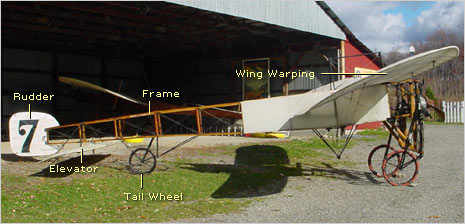

|

|

|
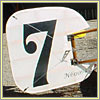
Used to control the lateral movement of the aircraft, this
feature is still found in contemporary designs.

|
|
Rudder
To steer the airplane—much like conventional airplanes
today—I have a rudder so I can make left turns and right
turns very simply by moving that stick and the rudder bar in
the cockpit. And this hasn't changed at all on this design.
This is pretty much the way it always was.
|
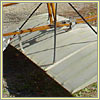
The elevator controls the pitch of the aircraft, allowing it
to climb or descend. Blériot was one of the first to
pair this with a rudder, creating a now-standard tail design.

|
|
Elevator
Moving the stick fore and aft has elevator control for pitch.
Pull back on the stick and up we go—and the other way
down. So, houses get smaller, and houses get bigger.
|

Despite its appearance, this feature only supports the tail
once the aircraft has stopped. Other versions of the Type XI
used bamboo skids instead of wheels.

|
|
Tail Wheel
This is the tail of the Blériot XI. There were several
designs. There was the wheel, like we have on this
Blériot XI. There was also another method of doing it
where it was bamboo cane that was bent around as a "tail
skid." And they used that too on some of the later
Blériots.
|
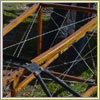
The body of the Type XI had to be both strong and lightweight,
so Blériot designed a system of wire cross-braces to
secure its wooden frame.

|
|
Frame
The construction of these airplanes—they're built a
little bit like a bridge. You can see that there are cross
wires that are tightening all these pieces together. All this
is held in compression and in the cross-brace it's giving you
the strength. Louis Blériot came up with his own style
of turnbuckles, and it's just a piece of stiff wire that runs
threaded between here and as you tighten these little nuts up
it would pull this wire tighter. And sometimes if you had a
hard landing or something you'd need to retighten them because
the wire would stretch. This was considered the Louis
Blériot style of a turnbuckle. Nobody else really
copied it. It was just a design very unique to Blériot
alone.
|
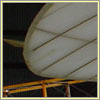
The Blériot XI uses wing warping, a flight control
system pioneered by the Wright brothers, to turn the aircraft
left and right.

|
|
Wing Warping
Okay, so for the wing warping, as I'm balancing the airplane I
can move the stick from side to side. That would warp the
wing, bending it almost like a bird, in order to bank the
airplane. When I'm flying the Blériot XI, in this
particular airplane I have very little power, so I have to be
very slow on the controls, be ready for any pitch change or
any attitude change that I have to correct right away.
Sometimes, if a wing goes down, moving the wing warp isn't
enough and I can actually physically shift my weight in the
seat, lean to one side, and very slowly that wing will come
back up again.
|
 Cockpit view
Cockpit view

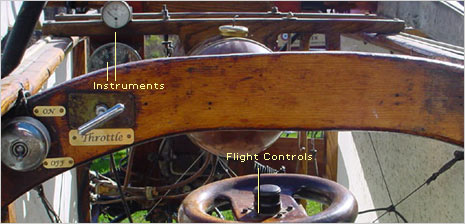

|

|

|
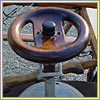
The Type XI features a single control stick and a set of foot
pedals to steer the aircraft, a configuration that remains
standard today.

|
|
Flight Controls
As you look at the cockpit you'll notice the control stick,
called the cloche, that bell-shaped housing that's named after
a lady's dress style of the period. The wheel on the top of
the control stick really doesn't turn or anything. It's just
something to hold on to. You can see the wires that are
attached just to the sides of that bell housing and those go
out to the control surfaces. They go to the elevators, to the
wing warp on the wings, and then you can see the rudder
bar—a wooden footrest almost—and that's what you
would use to operate the rudder. When I'm flying the
Blériot XI, in this particular airplane I have very
little power so I have to be not overly generous with the
control movement because you can get yourself into an awkward
attitude of the airplane where you may not be able to recover.
So everything in this airplane is done very slowly.
|
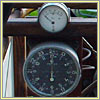
In 1909, aircraft cockpits had few if any flight instruments.
This Type XI features only two: an oil pressure gauge and a
tachometer.

|
|
Instruments
Blériots were used a great deal for the great circuit
races of Europe in 1911. And navigation was coming into its
own at that time, so they were learning about using maps and
using a compass and things like that. But in the early days
when they started out, instrumentation was very, very limited.
Usually it was just an oil pressure gauge, maybe an air speed
indicator, but for the most part it was just basic
instrumentation. Doing what I do when I fly this airplane is
flying what we call "by the seat of your pants." You really
just kind of feel how the airplane is that particular day when
you're taking off. Does it feel light? Can I pull back on the
stick? Oh, it's still going too slow: I have to lower the nose
a little bit. It's all done by feel.
|

|

|


